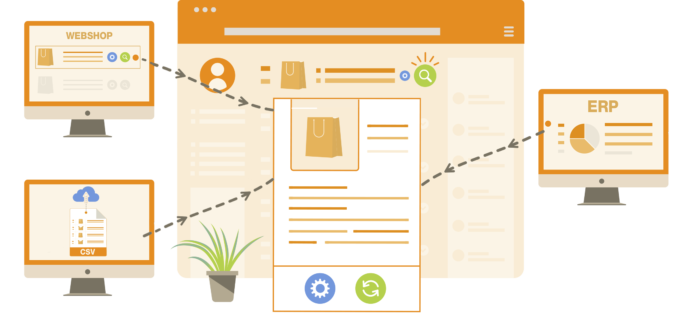Product Information Management system (PIM)
What is a Product Information Management System, and how does it help you to better organize your business?
Your products are the beating heart of your e-commerce business. But that ever-expanding product range also has drawbacks. Especially when you want to offer your wares on different marketplaces. It takes an enormous amount of time to properly manage product information and to ensure that it also corresponds to your stock. Product Information Management was created to tackle these sorts of challenges. But which PIM system will work for you and what exactly is a PIM system again?
A PIM system ensures that all of your data can be managed efficiently from one platform and subsequently can be distributed across all platforms where you offer your products. In fact, a PIM system regulates all of your information between the different systems that you already have. Think of your ERP system, your bookkeeping program, your POS system, your CRM, your webshops, and so on. A PIM system forms the basis of all your information: product descriptions, colours, measurements, images, instructional videos, and manuals. A PIM system then automatically shares this with your webshops, various marketplaces, your ERP software and all other systems which require the product data.

Can you do without it?
Of course. You can simply continue to enter the ever-increasing mountain of product data into each individual system. You could even keep lists in Excel or Word. However, you will find that this is not particularly efficient. Research shows that e-commerce businesses without a PIM system can easily take 60 minutes to process 1 item. Those are some very expensive minutes. With a PIM system, one change will be directly implemented everywhere. You don’t have to worry about that anymore. In this way, you can use that same hour to accomplish much more. Furthermore, a PIM system provides overview. You no longer need to manage or adjust your stock in different places. So, to come back to that question: ‘Can you do without it?’ No, actually you can’t. A PIM system is the backbone of an e-commerce business. In one fell swoop, it makes your e-commerce company completely efficient.
What are the advantages of a PIM system?
First and foremost then, time savings. But perhaps more important still is the consistency, and in turn the quality, of your data. By funneling all information through a PIM system all your data is the same everywhere. Plus, your product information is no longer saved in fragments in different systems such as your ERP, your CRM, your webshop, your bookkeeping program, your warehouse control system, your POS system and your mobile applications. The PIM ensures that all your product information is consistent and can be managed from one place and distributed to the correct channels. In addition, this means that all current information is available to your client: product descriptions, photos, and even suggestions for related products and alternatives. With a PIM system, it is also very easy to offer customers combinations of products.
Ultimately, using a PIM system leads to improved quality of information, consistent communication with your customers, and a unified image across all of your sales platforms. With a PIM system late or failed delivery no longer occurs; and that is on marketplaces where the competition is fierce and high levels of service are paramount. So, you attract and keep more satisfied customers.
The important advantage for you is that you keep control of your products, your stock, your sales and your margin. In other words: control of your business.
What PIM systems are there?
There are PIM systems of various sorts and sizes. From solutions for large retail companies to small webshops; from open-source and generic to tailor-made; from cheap to incredibly expensive; and from well-known software houses with a reputation built up through years of experience to obscure freeware. It is advisable not to make a snap decision when weighing up whether or not to use a PIM system. Ask yourself which functionalities are important for you and your business and check whether a PIM system communicates easily with the systems you are using already.
Advantages of the Sellable PIM system
Our PIM system is the backbone of Sellable and – no matter which subscription you choose – it is always included. With Sellable you can very easily:
– Integrate settings between your webshop, marketplaces, logistics partners and your ERP system. In this way your stock syncs automatically between your various sales channels.
– Upload CSV files and so add products in bulk, should Sellable unexpectedly not integrate with the systems you already have in use.
– Make, manage and change attributes (e.g. cost price, product description, pictures etc.) in one place and then push them through to various platforms.
– Make bulk changes: in this way products which you offer on the Dutch platform bol.com can very easily be added to bol.com BE or Amazon. Read more about bulk changes in this blog.
What do you need to be able to use the integrated PIM system from Sellable?
The only compulsory values are the SKU and the EAN (Stock Keeping Unit and European Article Number). The SKU may be the same as the EAN.
Would you like more information about what the PIM from Sellable can mean for your business? Ask for a demo now!
